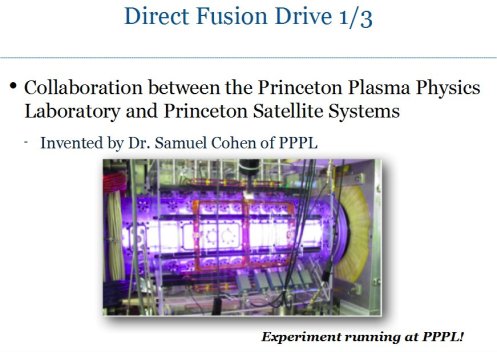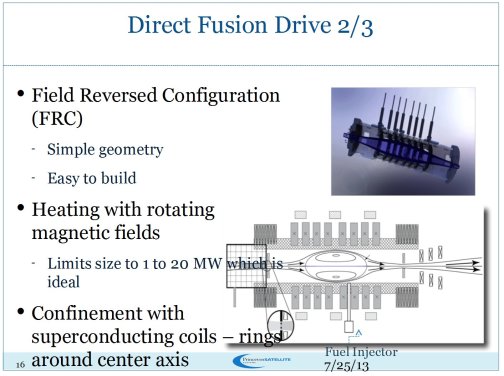The latest presentation to the Future In-Space Operations (FISO) study group is now posted in the FISO Working Group Presentations Archive. Both slides (pptx) and audio (mp3) are available for the talk, Direct Fusion Drive for Fast Mars Missions with the Orion Spacecraft, Joseph Mueller , Princeton Satellite Systems, July 24, 2013.
The Direct Fusion Drive mentioned here seems related to that of John Slough at the Univ. of Washington (see Update on Univ. Washington fusion propulsion project).


One big problematic issue beginning at slide 12 in the PowerPoint presentation. Transport to space is predicated on the existed of 130mton payload SLS Block II. No matter how good the science is behind the Direct Fusion Drive, they have shot themselves in the foot with that one faux pas.
Oops, typo, meant to say “predicated on the existence of 130mton payload SLS Block II”.
I don’t take it very seriously when people presenting space projects include the SLS in their presentations. They feel obligated to show the SLS because they think it might help with NASA grants. But doesn’t mean the SLS is truly needed for what they are doing. This fusion drive system here certainly could be assembled from Falcon Heavy size parts.
Okay. I hate to be That Guy, but this smells. Almost all of the energy released by a fusion reaction comes out as hard gamma rays and screaming hot neutrons traveling at a fat fraction of lightspeed. How do you “electromagnetically confine” those, with or without superconductors? Commercial electrical power generated by fusion has been “fifteen years away” since the Kennedy Administration.
Fission is relatively tame. Fission releases some gamma rays and relatively slow neutrons, but most all of the energy release is thermal. The big fat uranium or plutonium nucleus breaks into two or three chunks which separate energetically, then bump into surrounding atoms and heat up the bulk material. From an engineering perspective, it’s then trivial to extract work from this heat by boiling water with it to create steam to turn a turbine that’s connected to the generators.
Fusion, on the other hand, irradiates, poisons, and eats everything that’s near the reaction. Whatcha gonna do when the energy comes out as lethal radiation that irradiates and radioactively activates the material making up the control circuitry, and the irradiated concrete radiation shielding starts crumbling to radioactive dust? Whatcha gonna do when you throw the “on” switch and the fusion reactor starts spitting gamma rays and relativistic neutrons like a witch’s curse? How do you get a reaction drive out of this? For that matter, how could you use this to generate current for the North American grid?
Are we quite, quite sure this isn’t another Pentagon grey project to study nuclear fusion reactions in greater detail with an eye to applying the observations to improving the yield of our nukes?